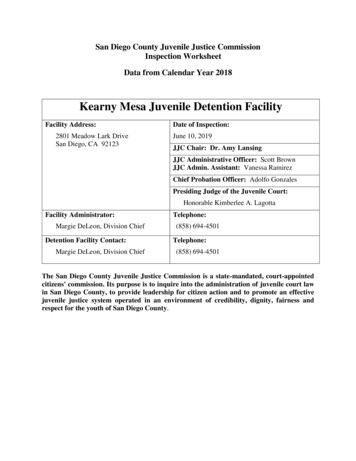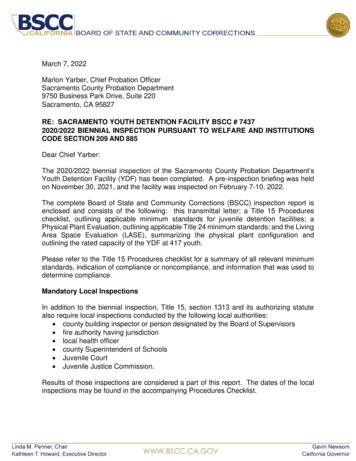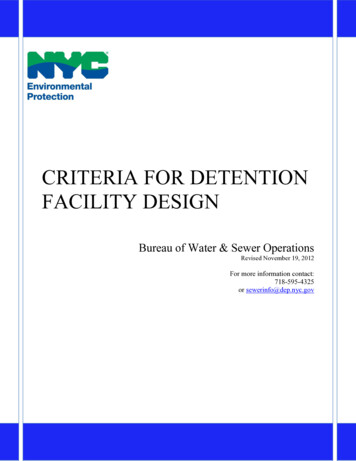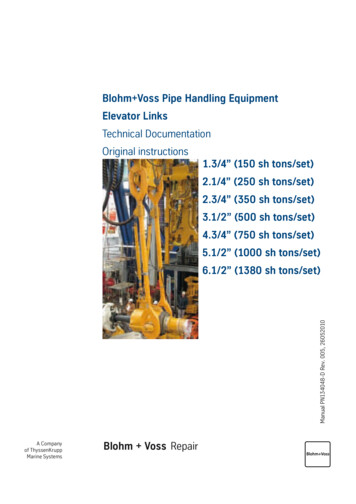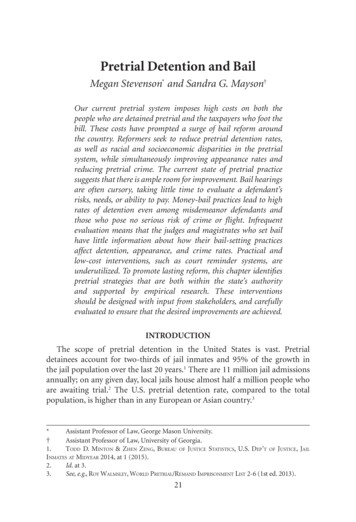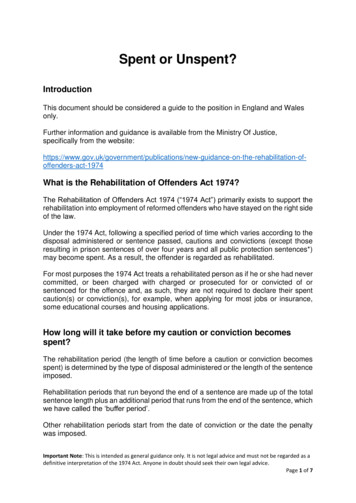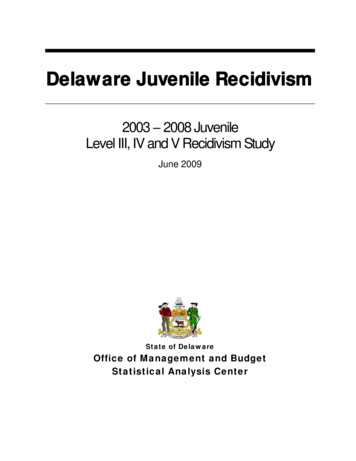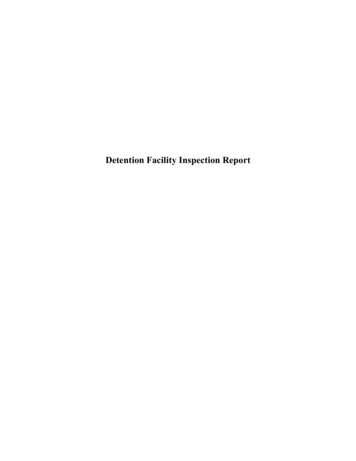
Transcription
Detention Facility Inspection Report
Detention Facility Inspection ReportSummaryThe 2017/2018 Nevada County Grand Jury (Jury) has conducted an inspection of the detentionfacilities in the County of Nevada (County) to “inquire into the conditions and management ofthe public prisons within the county” as required by Penal Code Section 919(b). The Jury touredand inspected the Wayne Brown Correctional Facility (Wayne Brown), the Carl F. Bryan IIJuvenile Hall (Juvenile Hall), the Washington Ridge Conservation Camp (Washington Ridge),and two holding facilities: the Nevada County Sheriff’s Office’s Truckee Sub-Station (TruckeeJail) and the Nevada County Superior Court Holding Facility in Nevada City (Nevada CityHolding Facility).There are three problems with the detention facilities that the Jury believes should be addressed.California law provides that the sheriff in each county may establish an Inmate Welfare Fund(IWF) to pay for services to inmates. The balance in the IWF at Wayne Brown at the end of the2016-2017 fiscal year was approximately 400,000. The Nevada County Sheriff’s Office(NCSO) has issued regulations concerning the administration of the Wayne Brown IWF but theregulations are not being followed. While the uses of the IWF are broadly discretionary and nomisuses of such funds are apparent, compliance with written policies is important when largeamounts of money are being collected and expended. The NCSO should either follow thepolicies it has promulgated or promulgate new policies that reflect how the IWF is beingadministered.The Jury also was concerned by the air quality it experienced in the Nevada City HoldingFacility. The Jury became more concerned when it could find no record of the air quality havingbeen tested. The multitude of unhealthy agents that could be present in the ill-ventilatedbasement of an old building requires at a minimum that testing be done.Finally, the 2015-2016 Grand Jury reported on the excessive costs associated with maintainingJuvenile Hall when the number of juvenile detainees has radically decreased. That reportestimated an excessive cost in the neighborhood of 2,000,000/year. Juvenile Hall continues inoperation notwithstanding that there are now even fewer detainees than there were two yearsago. While the programs offered at Juvenile Hall are exemplary, the cost is prohibitive. TheBoard of Supervisors must investigate alternatives to this over-expenditure of scarce Countyfunds.Other than those issues, in general, the Jury found the public prisons in the County to be wellmanaged and in good condition except for problems related to the age of the facilities at theNevada City Holding Facility and at the Truckee Jail. The Jury has issued a separate report onconditions related to the transport of prisoners to and from the Truckee Branch of the NevadaCounty Superior Court.2017-2018 Nevada County Grand Jury1
Glossary2015-2016 ReportAB109Cal FireCDCRCOCountyNevada City Holding FacilityIWFJuryJuvenile HallNCSOTAYTruckee JailWashington RidgeWayne BrownGrand Jury’s 2015-2016 Report entitled “Carl F. BryanII Regional Juvenile Hall - Is It Worth the Cost?”California Public Safety Realignment Act of 2011California Department of Forestry and Fire ProtectionCalifornia Department of Corrections andRehabilitationCorrectional OfficerCounty of NevadaNevada County Superior Court Holding FacilityInmate Welfare FundNevada County Grand JuryCarl F. Bryan II Juvenile HallNevada County Sheriff’s OfficeTransitional Age Youth ProgramNevada County Sheriff’s Office’s Truckee Sub-StationWashington Ridge Conservation CampWayne Brown Correctional FacilityBackgroundThe California Constitution of 1849 provides in Section 23 of Article 1 that a grand jury “bedrawn and summoned at least once a year in each county.” Accordingly, the Superior Court ineach of the 58 counties in the State yearly impanels a grand jury whose civil function is toinvestigate the operation of the various officers, departments, and agencies of local government.A grand jury may examine all aspects of county and city government, special districts, and othertax-supported organizations to ensure that the best interests of the citizens of the county arebeing served. The grand jury reviews and evaluates procedures, operations, and systems utilizedby local agencies to determine whether more effective methods may be employed.California Penal Code Section 919(b) requires each county’s grand jury to inquire annually intothe condition and management of public prisons within the county. The subject of this report isthe results of this year’s Jury’s inquiry into the condition and management of the public prisonsin the County.2017-2018 Nevada County Grand Jury2
ApproachThe Jury inspected each of the public prisons in the County as follows:Truckee JailNevada City Holding FacilityWayne BrownJuvenile HallWashington RidgeAugust 24, 2017September 7, 2017October 5, 2017January 11, 2018March 8, 2018These inspections included a walk-through of each facility, interviews, and a review ofprocedures and documents related to each facility. In addition, the Jury reviewed previous Juryreports on the facilities.The Jury observed the condition of each building and discussed the management of each facilitywith its staff. Where appropriate, the infirmary was inspected for any insufficiencies and/orhazardous conditions. The kitchen in each facility, where present, was inspected. Educationaland vocational programs as well as discipline and inmate grievance procedures were reviewed.Policies for inmate classification, orientation, and visitation were also reviewed.The following describes the current condition of each facility.Wayne Brown Correctional FacilityWayne Brown was originally opened in 1992 with a rated capacity of 239 inmates. Its capacityhas varied over the years. In 2007 the average daily population was 189 inmates but by 2016 theaverage daily population had increased to 210. In October 2017 it was 220. The current ratedcapacity is 283 inmates with 5 additional beds in the medical unit to be used as needed.Wayne Brown is staffed with three full-time deputies, 47 correctional officers (CO), and fivesergeants. The ratio of male to female COs is approximately 50/50. There is an ongoingproblem with maintaining mandatory minimum staffing due to a lack of applicants who can passthe background check needed to qualify. In addition, COs often apply to become deputies whenthe opportunity arises. The shortage of COs and mandatory minimum staffing requirementsresult in the regular need for mandatory overtime and shift extensions.The infirmary is staffed by one nurse. One nurse practitioner also is available during the dayshift to handle sick call. There is a doctor on call and one full time psychological worker tohandle psychological issues. Such issues have become more of a problem in recent years. Theseprofessionals evaluate mental disorders or competencies to determine if inmates should betransferred to a state hospital or other secure treatment facility.The Jury visited the housing pods, recreational room, toured the intake area including the sallyport, holding cells, safety cell, and reviewed the booking process. The housing and intake areaswere well maintained and clean. It appeared that there were sufficient surveillance cameras to2017-2018 Nevada County Grand Jury3
maintain the safety of inmates and staff. The Jury also interviewed prisoners away from staff fortheir input into jail operations.All cooking and baking is performed in-house at Wayne Brown. The kitchen is commercialgrade and is staffed by federal inmates who are eligible to do such work. Due to the longer termsfor such federal inmates, they provide more continuity in the kitchen. Unfortunately, the kitchendoes not offer food handler certification to help in job placement when inmates return to societyas does the kitchen at Juvenile Hall.The traditional library has been replaced by digital resources. The former library room has beenconverted to a space for mindfulness stress reduction programs, inmate dramatic productions,and other recreational opportunities.There were several areas of concern in connection with the operation of Wayne Brown. First,the Public Safety Realignment Act of 2011 (AB109) transferred certain inmates from Stateprison to county jails and increased the number of felons in county jails. In the past, the normalmaximum term in county jails was one year. Wayne Brown, like most county jails, was notdesigned for housing long-term inmates. It lacks, for example, the recreation facilities that areoffered in state prisons. It is not clear how this issue can be resolved without State intervention.Another area of concern is the management of the IWF. The IWF is established by Penal CodeSec. 4025 which states: “The sheriff of each county may establish, maintain and operate a storein connection with the county jail and for this purpose may purchase confectionery, tobacco andtobacco users' supplies, postage and writing materials, and toilet articles and supplies and sellthese goods, articles, and supplies for cash to inmates in the jail.” Subsequent subsections speakto other sources of revenue for the IWF. Substantial amounts of money are involved. Thebalance of funds in the Wayne Brown IWF at the beginning of 2017 was 399,901.Pursuant to the statute, the permitted uses of funds from the IWF are, among others: generally, uses primarily for the benefit, education, and welfare of the inmates confinedwithin the jail; the salary and benefits of personnel used in the programs to benefit the inmates such aseducation, drug and alcohol treatment, and “other programs deemed appropriate by thesheriff;” and to augment those required county expenses such as meals, clothing, housing, or medicalservices “as determined by the sheriff to be in the best interests of inmates.”Thus, use of IWF funds is broadly discretionary. It appears that the NCSO has adopted aconservative approach to the use of IWF funds, keeping close to the statutorily approved uses.The NCSO has adopted a directive (Corrections Division Directive #64) “[t]o establishprocedure [sic] for the administration of the Inmate Welfare Fund.” Directive #64 establishesnumerous operational procedures for the IWF. However, the NCSO appears to be out ofcompliance with Directive #64 as follows:2017-2018 Nevada County Grand Jury4
Section A of Directive #64 establishes a Welfare Fund Committee comprising 3 votingmembers: the Facilities Operations Lieutenant, the Facility Support Lieutenant, and a“volunteer member from the general public.” Directive #64 provides that “[t]hecommittee shall provide advice and counsel regarding administration and expenditures ofthe Inmate Welfare Trust Fund.” There currently is no Welfare Fund Committee. Thereis no input from a member of the general public. Decisions about purchases from theIWF currently are reviewed up the chain of command in the same manner as non-IWFexpenditures. Section B of Directive #64 sets forth “Staff Duties” for a Facility Support Lieutenant, anAccounting Assistant, and a Program Manager. Currently, the “Staff Duties” provisionsof Directive #64 are not followed. It appears that the listed duties are carried out but notby the staff designated in Directive #64. Section E of Directive #64 provides that “Inmate Welfare Fund property will be assigneda permanent welfare fund ID number and entered onto an asset inventory list. Aninventory will be conducted annually by the Facility Support Lieutenant and the ProgramManager.” There currently are no inventories maintained as required by Section E. Ageneral inventory of items above a designated price threshold is maintained at WayneBrown but there is no separate inventory for the IWF.There is no statute or policy that requires the NCSO to follow its own directives concerning theIWF. Nor have we been able to find any source of “best practices” concerning the operations ofan IWF in California. There is a separate statute, Penal Code Sec. 5005, that establishes IWFs inthe State prisons and it specifically requires biennial audits and, in the intervening years, a“statement of operations.” However, that statute does not apply to IWFs in county jails likeWayne Brown.No audit of the IWF has been performed by the County Auditor nor are transactions in the IWFreviewed by anyone other than the NCSO. The Auditor-Controller has not performed a separateaudit of the fund but individual transactions are reviewed by that office. The Jury has not foundany suspicious financial activity related to the IWF but the lack of an inventory and the sporadicsummary reports of financial activity provided to the Board of Supervisors make any analysis ofIWF income and expenditures challenging.Carl F. Bryan II Juvenile HallPursuant to California law, only persons under 18 years of age at the time of his or her violationcan be held in juvenile detention facilities. For a variety of reasons discussed in detail in theJury’s 2015-2016 report, entitled Carl F. Bryan II Regional Juvenile Hall - Is It Worth the Cost?(2015-2016 Report), there is an ongoing national and local trend away from incarceration ofjuveniles and in favor of alternatives to detention including release on recognizance, release onbond, community support, and formal evidence-based monitoring programs. At the time of theJury’s inspection of Juvenile Hall, there were four detainees resident in a facility configured tohold 30 detainees. All four of the detainees were from Nevada County. While the County has2017-2018 Nevada County Grand Jury5
agreements with neighboring counties for the detention of juveniles from those counties atJuvenile Hall, there have not been any such detainees at Juvenile Hall for several months. Onereason for the drop off in detainees from other counties is the recent completion of a newjuvenile facility in Tuolumne County.As discussed in the 2015-2016 Report, one result of the decrease in juvenile detention and themaintenance of state-mandated staffing levels has been a steadily rising cost per detainee. A newCalifornia program called the Transitional Age Youth Program (TAY) has been in effect forabout a year. The TAY program relates to detainees who are 18 years of age or older but under21 years of age on the date their offense was committed. It permits incarceration of suchdetainees outside of county jails in facilities such as Juvenile Hall that offer programs forrehabilitation. Modifications have been made to Juvenile Hall so that detainees in the TAYprogram can be detained there but not co-mingled with the 17 and under detainees. It was hopedthat the TAY program would increase the number of detainees at Juvenile Hall and reduce thecost per detainee. Unfortunately, very few detainees eligible for TAY have been available andthere has been no amelioration of the financial difficulties that were discussed in the 2015-2016Report.The County continues to spend upwards of 2,000,000 on Juvenile Hall that could be saved byplacing juvenile detainees in juvenile halls in other counties. In its response to the 2015-2016Report, the Board of Supervisors asserted that housing detainees in other counties would increasecosts by requiring NCSO deputies or Probation officers drive detainees to and from the places ofdetention. However, we note that all of the contracts that the County entered into withneighboring counties for detention of their juveniles at Juvenile Hall provided that NevadaCounty would bear the costs of transportation. Hence, we would expect that Nevada Countywould not incur those costs in sending juveniles the other way.At the time of the Jury’s visit, we observed that the facility is clean and well maintained. Thereare numerous programs and incentives to help detainees get a fresh start. Recreational facilitiesand educational programs are provided. Detainees are able to acquire work skills in gardeningand the culinary arts. All meals are prepared onsite and detainees can earn culinary workercertifications that can be used for work after they are released.The interaction between inmates and COs appeared to be cordial. The staff appears to beforward thinking and firm but respectful of their charges.Juvenile Hall experienced a brief period of intensive use last summer when detainees from theYuba and Sutter County juvenile halls, at risk during the Oroville Dam crisis, were transferredhere. Thirty-four new detainees arrived on very short notice. By all accounts, the staff andfacilities performed well. The kitchen was able to ramp up to meet the increased needs and evengot some of the Yuba and Sutter detainees working on food preparation.In summary, it appears that Juvenile Hall continues to be a well-run and maintained facility.While the financial issues discussed in the 2015-2016 Report, in particular the 2,000,000 annualexcess cost, continue to be a concern, the administration and staff continue to work onencouraging uses that could reduce the financial problems. One promising possibility involves2017-2018 Nevada County Grand Jury6
the use of the building as a regional facility for incarceration and treatment of prisoners withmental health issues. Such a use is in very preliminary stages of discussion but, if it is possible,could help solve an ongoing and increasing problem in jails in the foothill counties.In its response to the 2015-2016 Report the Board of Supervisors pointed out that “ResolutionNo. 00-427, dated September 5, 2000, passed by the Nevada County Board of Supervisors, toreceive the Construction Grants Program Grant Contract between the State Board of Correctionsand County of Nevada, funding to build the Carl F. Bryan II Juvenile Hall stipulates in ExhibitD, page 1 of 4, "The Grantee assures and certifies that it: will not dispose of, modify the use of,or change the terms of the real property title, or other interest in the site or facilities, or lease thefacility for operation by other entities, without permission and instructions from the Office ofJuvenile Programs, U.S. Department of Justice." We note that the TAY program comprised suchan alternative use and the approval for that alternate use from the U.S. Department of Justice wasobtained through a brief exchange of emails. It is difficult to believe that the Department ofJustice will force the County to operate Juvenile Hall at an excess cost of 2 million per year.The Jury has no further recommendations for change at this time. The Jury again entreats theBoard of Supervisors to consider closing down Juvenile Hall and to find an alternative use of thefacility. While the programs offered at Juvenile Hall are exemplary, the cost is prohibitive.Washington Ridge Conservation CampWashington Ridge, located northeast of Nevada City off Route 20, is one of 44 conservationcamps administered jointly by the California Department of Corrections and Rehabilitation(CDCR) and the California Department of Forestry and Fire Protection (Cal Fire). Thecooperation between CDCR and Cal Fire is impressive. While in the camp the inmates are underthe supervision of CDCR but when working as firefighters or performing community serviceprojects, they are under the supervision of Cal Fire. CDCR officers are on duty at all times.Washington Ridge has a resident inmate capacity of 100 but can handle up to 300 additionalfirefighters when necessary to respond to major disasters. The current inmate population is 78including support inmates assigned to do the cooking, cleaning, yard maintenance, andequipment maintenance and repair. The primary cause of the camp operating below capacity isthe reassignment of non-violent offenders from State prisons to county jails as mandated byAB109. As a consequence of AB109, the eligible pool of inmates available for assignment toconservation camps has decreased over the years. In response, the CDCR and Cal Fire havestarted to broaden the prerequisites for eligibility to serve time in the conservation camps. Inaddition, they have sought to encourage county sheriffs to transfer eligible inmates from countyjails to conservation camps. There currently is one NCSO inmate serving at Washington Ridge.The cost to the County for that inmate being housed and fed at Washington Ridge is 10/day.The camp is self-sufficient. It has its own well and a back-up generator that can run the wholecamp. It maintains five fire trucks each having a crew of 13-17 inmates. The trucks areequipped to be self-sustaining for days, if necessary. The inmates do the maintenance on thetrucks and on the other fire-fighting equipment including chainsaws and hand tools.2017-2018 Nevada County Grand Jury7
The firefighting inmates are selected in a multi-step process and are carefully trained to performtheir dangerous duty. Even though many man-hours of service are provided yearly fighting fireswithin the State the number of accidents is very low. In addition to firefighting, the crewsperform needed work in the community. Local projects have included cutting firewood, workingin public parks, and performing needed work for nonprofit programs such as maintenance forparks and sports fields. Crews are available for 250 per day for a full crew for counties, cities,and certain nonprofit organizations. Washington Ridge estimates that local communities havesaved 3.5 million in the last year due to the use of Washington Ridge inmates doing communityimprovement projects. During 2017, Washington Ridge inmates did an estimated 115,000 hoursof community service work and 69,000 hours of firefighting.Washington Ridge continues to be a well-run and maintained facility. The Jury has norecommendations for changes or improvements at this time.Nevada County Sheriff’s Office’s Truckee Sub-StationThe Truckee Jail is used to temporarily hold inmates arrested in eastern Nevada County untilthey can be transferred to Wayne Brown and to house inmates transferred from Wayne Brown tostand trial at the Truckee Branch Courthouse. The Truckee Jail also serves as a holding facilityfor the Truckee Police Department, the Sheriff Departments of Sierra and Placer Counties, andthe California Department of Parks and Recreation. There is 24-hour staffing with a minimum oftwo COs including one female CO and two trustees. One trustee is on site full time and one parttime. Transportation to and from Wayne Brown is the responsibility of NCSO deputies. Inaddition to staff on duty, first response medical personnel and the local fire department serve thefacility as needed.The Truckee Jail was built in the early 1960s and it is showing its age. Nevertheless, it appearsto be adequate for its limited use. The Jury has issued a separate report on conditions related tothe transport of prisoners to and from the Truckee Branch of the Nevada County Superior Court.Nevada County Superior Court Holding FacilityThe Jury inspected the Nevada City Holding Facility including its administrative offices, thesecurity monitoring station, its cells, the hallways leading to the courtrooms, and the sally portthrough which the prisoners are brought into the facility. We questioned the deputies and theCOs regarding their duties, prisoner treatment, safety of the prisoners, safety of the public,security, maintenance of the hygiene level, and air quality in the building.Inmates brought to the Nevada City Holding Facility arrive in a law enforcement vehicle at thesally port and are escorted into the holding area where they are secured in individual cells. Whenit is time for the inmate’s court appearance, the inmate is chained and handcuffed, and thenescorted through public hallways and the lobby into a courtroom where the inmate is guarded byan armed deputy sheriff.2017-2018 Nevada County Grand Jury8
The Nevada City Holding Facility includes a control room where multiple cameras allow theCOs to monitor the movements of inmates from the cells to the courtrooms. There also arecameras directed at entrances and exits to the courthouse and some on the exterior of the buildingto help control access. The cell area was clean and well maintained, and nothing appeared to bea potential danger for either the prisoners or the COs who supervise the prisoners.Although there is little risk of escape, the location of a public access door into the lobby on theeast side of the first floor does present an enticement to the prisoner. Because of the restraintsemployed and the alertness of the officers, any prisoner who attempts to flee is unlikely to besuccessful.There is an air quality problem in the area where the NCSO’s administrative offices and securitymonitoring station are located. The County is responsible for the maintenance of the buildingand the Jury could find no record that the County has made any effort to measure air quality atthat location. Asked about air quality in the control center, no one could remember it havingbeen tested. Moreover, no one knew if or when maintenance had been performed on theventilation system. This is a potential issue for both inmates and COs because of the propensityof bacteria to flourish in a closed environment with many different individuals passing through.During our visit, two members of the Jury were affected by the quality of the air.The age of the building also causes concern about the existence of asbestos possibly being usedin its construction. If so, it creates a health hazard to the lungs of everyone who enters thebuilding, and especially those who remain in it for a prolonged period.FindingsF1The written policies and procedures of the Sheriff’s Office concerning the InmateWelfare Fund are not being followed.F2The County continues to spend upwards of 2,000,000 on Juvenile Hall that could besaved by placing juvenile detainees in juvenile halls in other counties.F3The air quality in the administrative and holding cell area at the Nevada CountyCourthouse Holding Facility in Nevada City is poor.RecommendationsThe Nevada County Grand Jury recommends:R1The Nevada County Sheriff’s Office should comply with the regulations that it hasestablished for the administration of the Inmate Welfare Fund at the Wayne BrownCorrectional Facility.2017-2018 Nevada County Grand Jury9
R2Alternatively, the Nevada County Sheriff’s Office should draft new regulations thatdescribe procedures that actually are being followed in connection with theadministration of the Inmate Welfare Fund.R3The Nevada County Board of Supervisors should undertake an urgent review ofalternatives to the current use of Juvenile Hall to explore more cost-effective uses of thefacility and to explore the placement of Nevada County juvenile detainees in juvenilehalls in neighboring counties.R4The Nevada County Sheriff’s Office and the Nevada County Board of Supervisorsshould cause tests to be done of the air quality in the Nevada County CourthouseHolding Facility in Nevada City to insure that it is safe.Request for ResponsesPursuant to Penal Code section 933.05, the Nevada County Grand Jury requests responses fromthe following:Nevada County Sheriff’s Office – Findings F1 and F3 and Recommendations R1, R2,and R4 by 9 August 2018.Nevada County Board of Supervisors - Finding F2 and Recommendations R3 and R4 by9 August 2018.2017-2018 Nevada County Grand Jury10
Wayne Brown Wayne Brown Correctional Facility Background The California Constitution of 1849 provides in Section 23 of Article 1 that a grand jury "be drawn and summoned at least once a year in each county." Accordingly, the Superior Court in each of the 58 counties in the State yearly impanels a grand jury whose civil function is to
